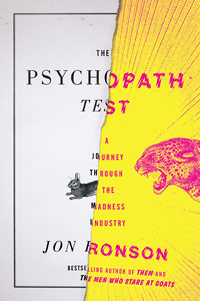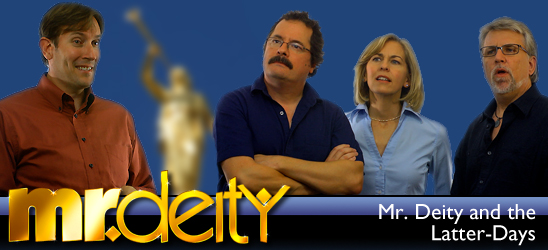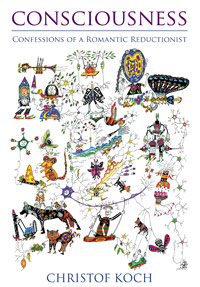In this week’s eSkeptic:

NEW ON MICHAELSHERMER.COM
Much Ado about Nothing
Why is there something rather than nothing? This is one of those profound questions that is easy to ask but difficult to answer. In Michael Shermer’s May “Skeptic” column for Scientific American, he discusses several of the various scientific theories for why there is something (a universe) rather than nothing.
Our Next Lecture at Caltech:
Dr. Christof Koch
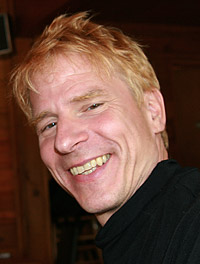
Consciousness: Confessions of a Romantic Reductionist
Sunday, May 13, 2012 at 2 pm
Baxter Lecture Hall
WHAT LINKS CONSCIOUS EXPERIENCE OF PAIN, joy, color, and smell to bioelectrical activity in the brain? How can anything physical give rise to nonphysical, subjective, conscious states? Neuroscientist Christof Koch has devoted much of his career to bridging the seemingly unbridgeable gap between the physics of the brain and phenomenal experience. Koch recounts not only the birth of the modern science of consciousness but also the subterranean motivation for his quest—his instinctual (if “romantic”) belief that life is meaningful. Koch describes his own groundbreaking work with Francis Crick in the 1990s and 2000s and the gradual emergence of consciousness (once considered a “fringy” subject) as a legitimate topic for scientific investigation. Koch gives us stories from the front lines of modern research into the neurobiology of consciousness as well as his own reflections on a variety of topics, including the distinction between attention and awareness, the unconscious, how neurons respond to Homer Simpson, the physics and biology of free will, dogs, sentient machines, and Der Ring des Nibelungen.
TICKETS are first come, first served at the door. Seating is limited. $8 for Skeptics Society members and the JPL/Caltech community, $10 for nonmembers. Your admission fee is a donation that pays for our lecture expenses.
Followed by…
The Secrets of Mental Math: The Mathemagician’s Guide
to Lightning Calculation and Amazing Math Tricks
with Dr. Art Benjamin, Sunday, June 10, 2012 at 2 pm
Baxter Lecture Hall, Caltech, Pasadena, CA

Qu’est Que C’est?
Remorseless killers are the stuff of countless films. Sadly, the real world has even more of them. Jack the Ripper, Ted Bundy, H. H. Holmes, John Wayne Gacy—these remorseless psychopaths filled graveyards with corpses and sleeping minds with nightmares. But these aren’t monsters—they’re real people who have a brain that developed differently than most peoples. Author Jon Ronson joins us on this episode of MonsterTalk to discuss the condition of psychopathy—and to share with us his journey into the world of these dangerous people.
The Latest Episode of Mr. Deity: Mr. Deity and the Latter-Days
WATCH THIS EPISODE | DONATE | NEWSLETTER | FACEBOOK | MrDeity.com
About this week’s eSkeptic
In this week’s eSkeptic, Ueli Rutishauser reviews Christof Koch’s latest book entitled, Consciousness: Confessions of a Romantic Reductionist (Cambridge: MIT Press, 2012, ISBN-13: 978-0262017497). Dr. Koch will present a lecture at Caltech (based on this book) on May 13, 2012 at 2pm.
Ueli Rutishauser is a neuroscientist who studies the neural mechanisms by which animals learn. He records the activity of single neurons in the human brain in neurosurgical epilepsy patients, which has lead to the discovery of novelty detecting neurons. He is a Group Leader at the Max Planck Institute for Brain Research in Frankfurt am Main, Germany and holds a Ph.D. in Computation & Neural Systems from the California Institute of Technology. His research has been published in journals such as Nature, Neuron, Current Biology, Neural Computation, and Proceedings of the National Academy of Science.
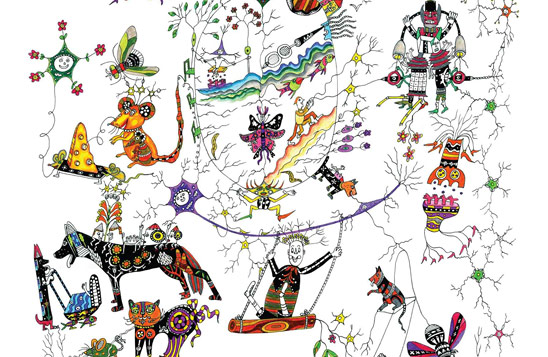
What’s it Like to be a Brain?
by Ueli Rutishauser
The human brain is the most complex system ever studied, but it is nevertheless a physical system obeying physical laws. How is it that this system, unlike many others, has subjective internal states and experiences? Why does it feel like something to be the conscious person you are? Why do we feel personal ownership and responsibility for our actions?
Historic and religious approaches to the ancient mind-body distinction have called for some form of dualism to bridge the physical and the mental. However, the advent of modern neuroscience with its increasingly detailed understanding of the inner workings of the brain has given rise to the hope that we will be able to conquer this final frontier and reduce the mind to the brain, to give a rational explanation of the subjective. This quest has lead to the birth of the scientific study of consciousness, which was previously the exclusive providence of philosophy.
In his new book, Caltech neuroscientist Christof Koch describes what the latest findings from the front lines of neurobiology tell us about consciousness and free will together with his innermost thoughts, feelings and motivations in a highly personal narrative. Koch’s previous book, Quest for Consciousness (Roberts & Company, 2004), which has become a standard scholarly text, laid out the scientific rational for the search for what he and his collaborator Francis Crick coined the neural correlates of consciousness. In contrast, Koch’s new book gives readers an unusually personal view into how and why he conducts his science, how new results emerge and what deep motivations are driving the author as a scientist and person to devote decades of his life to the quest of explaining consciousness. “I want to know before I die,” he confesses, “so I can’t afford to wait forever.”
Much has been written by philosophers about subjective thoughts and feelings, leading to heated debates between proponents of various “isms”. However, philosophy can merely be speculative. “Philosophers deal in belief systems, simple logic, and opinions, not in natural laws and facts,” Koch notes, “but they have a mediocre historical record of prognostication.” He describes a conversation with philosopher David Chalmers, who coined the term “The Hard Problem” for explaining consciousness. Chalmers claimed that consciousness would forever resist rational explanation and that no future discovery or conceptual advance could ever convince him otherwise. On the contrary, Koch argues that scientific and technological developments have allowed humanity to understand phenomena previously resistant to rational explanation and that this will undoubtedly also be the case for the problem of how a physical system can give rise to subjective experience.
Koch’s approach is anchored in the principle that there is a minimal set of neuronal mechanisms that are jointly sufficient for a specific conscious percept—the neural correlates of consciousness (NCC). According to this definition, most neurons are not part of the NCC. For example, activity in the retina is correlated with visual consciousness, but is not sufficient to cause it. In fact, most retinal activity never makes it into awareness. In binocular rivalry, activity in early visual cortex (V1) does not predict conscious awareness, whereas activity in higher areas such as inferotemporal (IT) cortex does. Thus, Koch concludes that some neurons in IT are likely to be part of the NCC whereas neurons in the retina or V1 are not. Further, he notes that “large parts of the cerebral cortex can be destroyed without any overall loss of function after recovery” and these are thus not part of the NCC either. The cerebellum, for example, contains more neurons than the human cortex, but its loss does not impair consciousness but rather fine motor movements. On the other hand, a comparatively small bilateral lesion in a particular area of the brainstem leads to irreversible loss of consciousness, leaving the person in a vegetative state. This is an example of what Koch calls enabling factors of consciousness—neurons without which consciousness cannot exist but activation of which does not in itself cause a particular conscious percept. The NCC proper, the specific factors, consist of the particular neuronal events that cause the percept. Localized lesions, such as those leading to an inability to see color or faces, impair particular NCCs. Thus, the NCCs are both highly localized and specific as opposed to being a holistic global property of the brain. Koch’s quest hinges on identifying these specific factors, a strategy that has been very successful in driving research.
If a neuronal mechanism is sufficient to cause a subjective percept, activation of this NCC should both precede the percept in time and cause it some time later. Experimental evidence for NCCs comes from electrical stimulation with microelectrodes during surgical procedures. Depending on the stimulation site, these evoke a smell, a memory of your grandmother, the urge to move a limb, or feelings of familiarity—all subjective percepts. Koch, together with his UCLA collaborator Itzhak Fried, has discovered concept cells deep within the temporal lobes. They are active when viewing images of a particular person such as Bill Clinton, but also when seeing his name written on a screen or hearing him speak. New findings described in the book also show that these cells are activated when people think about a concept, leading Koch to conclude that they are likely part of the NCC for the concepts that they respond to and are presumably also the neurons that are activated by the electrical stimulation that led to the conscious percepts.
These immensely important findings result from observing and disturbing the brain in the currency in which it operates—the neuron. As Koch poignantly notes, they go much beyond the often naive phrenological interpretations made based on “hot spots” found using neuroimaging techniques such as fMRI or PET that tell us little about what particular neurons are doing but frequently are the only evidence for claims that some area is “the neural correlate” of something. In Koch’s words, “consciousness does not arise from regions but from highly networked neurons within and across neurons.” The claims that have been made as to the “neural correlates” of consciousness-related functions based entirely on neuroimaging are troublesome. Even if we assume that such functions can be localized, they only tell us where something happens, not how and why. Neurons are the atoms of perception, so this should be the unit of measurement.
What about the neural mechanisms that constitute the NCC enables them to generate phenomenal experience? Koch believes that consciousness is a fundamental property of organized matter that cannot be further reduced to elementary properties. This belief rests on information theoretic arguments. Koch provides a very readable description of how the interaction of physical elements could lead to subjective states—the theory of integrated information. In the consciousness literature, theoretical too often stands for speculative descriptive models. Refreshingly, in this case it means a mathematical model. While this is the most speculative chapter of the book, it makes predictions that can be validated. The theory predicts to what extend a particular system is conscious. Is a dog conscious and if so how is it different from an awake human? How about a human in a coma? How about an iPhone? Koch argues that any system is conscious to some degree, permitting, in principle, conscious machines. It also follows that even simple animals have some degree of phenomenal experience.
As is so often the case in science, the question of what consciousness is can be reduced to “How can we measure it?” Conscious states are highly informative since each differentiates between many possible other states by ruling them out. At the same time, any such state integrates a large amount of information. The theory proposes a quantity called “Phi” that quantifies, in units of bits, the amount of integrated information generated by a particular state above and beyond the information provided by the parts. Phi specifies the quantity of conscious experience that this particular state provides. The total number of all possible such states that a system has specifies the quality of conscious experience. While computationally expensive, Phi can be calculated for both biological and artificial networks.
The integrated information approach predicts that in states of reduced consciousness, information in the brain should propagate less readily. This can be measured by estimating the spread of a disturbance caused by transcranial magnetic stimulation. Indeed, experiments show that such disturbance spreads widely in awake brains, whereas it stays local in deep sleep. Illustrating the power and potential usefulness of this approach for building a “conscious-meter,” this measure could differentiate between patients who are either in a vegetative state or a minimally conscious state. Distinguishing between different states of unconsciousness is an incredibly difficult task that would be greatly facilitated by such a measurement. Intriguingly, this approach could also predict which coma patients would later regain awareness.
Free will is a difficult and discomforting topic to which Koch provides an insightful perspective. After summarizing arguments from classical and quantum physics, Koch concludes that at present it is unknown how the brain makes decisions which are “free”—neither random nor pre-determined. Nevertheless, he identifies possible sources of indeterminism that, in principle, allow free decisions. The argument is that we do not have free will in the Cartesian or libertarian sense because it is incompatible with determinism. That is, given a past decision and exactly identical circumstances (including internal brain state), we could not have acted other than we did. In contrast, most scientists believe in compatibilism, which holds that we are free if we can follow our own desires and preferences. But determinism does not imply predictable—the future of a complex deterministic system is inherently unpredictable even in the absence of randomness (which is apparent everywhere in the nervous system).
We believe that we have free will because of the sense of agency, the feeling that we willed an action. Koch argues that the feeling of agency is nothing but a conscious percept, with an NCC that can be studied like any other. The brain makes decisions before the conscious mind is aware a decision has been made. This tells us neither how decisions are made nor that we lack free will, but that decisions are made before we become aware of them and that agency plays no role in making them. The agency aspect of free will is orthogonal to how decisions are made.
I found Confessions of a Romantic Reductionist to be highly engaging, making inroads into several deeply difficult and controversial topics and enlightening each with what modern neurobiology has to offer. Its assessment of the state of the art is enthusiastic but fair, making clear that we are only at the very beginning of this quest. As such, Koch’s assessment of our present understanding of neuronal processes and how these give rise to consciousness shows that we are still very far from Ray Kurzweil’s singularity, the point at which computers reach human-level intelligence. Confessions of a Romantic Reductionist combines cutting edge science with personal stories—including the author’s struggle with religion—and I highly recommend it for anyone with an interest in consciousness and its neural basis.
Skeptical perspectives on consciousness
from Christof Koch…
-
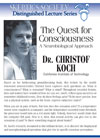 The Quest for Consciousness
The Quest for Consciousness
by Dr. Christof Koch
-
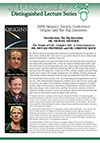 Origins & The Big Questions:
Origins & The Big Questions:
Conference 2008. Part 1
with Dr. Christof Koch
-
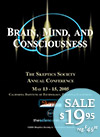 Brain, Mind, Consciousness:
Brain, Mind, Consciousness:
Conference 2005
with Dr. Christof Koch


